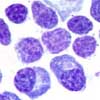Lymphoplasmacytic lymphoma (Waldenström's macroglobulinemia)
Abstract:
Waldenström's macroglobulinemia is included in the mature B-cell lymphatic neoplasms lymphatic neoplasms . It is a lymphoplasmacytic B-cell lymphoma with secretion of an IgM-paraprotein. Morphologically, there is an infiltration of small lymphocytes, lymphoplasmacytic elements and plasma cells. If IgM values are high, a hyperviscosity syndrome may occur. Waldenström's macroglobulinemia is rare.
Even less frequent are lymphoplasmacytic lymphomas secreting IgG or IgA. In these, hyperviscosity syndrome does not occur.
Clinical picture:
Hyperviscosity syndrome, which can occur with high IgM concentrations, is typical for Waldenström's macroglobulinemia. Common symptoms include confusion, visual impairment and other neurological symptoms. Enlarged lymph nodes and hepatosplenomegaly are also common. Therapy consists of plasmapheresis as well as chemotherapy.
Lymphoplasmacytic lymphomas mostly infiltrate the bone marrow. In 15-30% of the cases, there is a splenomegaly, lymphadenopathy and hepatosplenomegaly. The lymphoma has typically a slowly progressing course with only few and mild symptoms. Patients suffer weakness, fatigue, anemia and less frequently from thrombocytopenia and neutropenia. The IgM-paraprotein can lead to cryoglobulinemia, autoimmune phenomena and gastrointestinal deposition of paraproteins with diarrhea.
Hematology:
Anemia, thrombocytopenia and neutropenia of various degrees occur due to the replacement of normal hematopoiesis by the lymphoplasmacytic elements. In the peripheral blood, an increase of lymphoplasmacytic lymphocytes may be observed.
Bone marrow:

The bone marrow is almost always affected. There is a nodular, diffuse or interstitial infiltration by lymphoplasmacytic elements. These consist in small lymphocytes, lymphoplasmacytic transitional forms and plasma cells. Para-trabecular infiltrations are typical. Mast cells are often increased. Occasionally, so called Dutcher-bodies are seen above the nuclei of the lymphoplasmacytic elements. These are cytoplasmic inclusions containing immunoglobulins.
Diagnosis:
By immunophenotyping, this lymphoma is characterized by a positive reaction for CD19, CD20, CD22, CD79a, CD79b, CD27 and FMC7 as well as frequently for CD25 and CD38. CD5, CD10, CD103 and CD23 are mostly negative. The plasma cells express CD138. The mutation L265P of gene MYD88 is found in the majority of lymphoplasmacytic lymphomas, but only sporadically in other B-cell-lymphomas. It can be demonstrated by PCR.